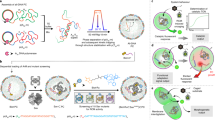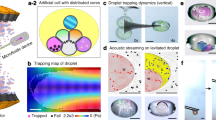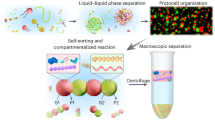Abstract
Artificial cell-like communities participate in diverse modes of chemical interaction but exhibit minimal interfacing with their local environment. Here we develop an interactive microsystem based on the immobilization of a population of enzyme-active semipermeable proteinosomes within a helical hydrogel filament to implement signal-induced movement. We attach large single-polynucleotide/peptide microcapsules at one or both ends of the helical protocell filament to produce free-standing soft microactuators that sense and process chemical signals to perform mechanical work. Different modes of translocation are achieved by synergistic or antagonistic enzyme reactions located within the helical connector or inside the attached microcapsule loads. Mounting the microactuators on a ratchet-like surface produces a directional push–pull movement. Our methodology opens up a route to protocell-based chemical systems capable of utilizing mechanical work and provides a step towards the engineering of soft microscale objects with increased levels of operational autonomy.

This is a preview of subscription content, access via your institution
Access options
Access Nature and 54 other Nature Portfolio journals
Get Nature+, our best-value online-access subscription
$29.99 / 30 days
cancel any time
Subscribe to this journal
Receive 12 print issues and online access
$259.00 per year
only $21.58 per issue
Buy this article
- Purchase on Springer Link
- Instant access to full article PDF
Prices may be subject to local taxes which are calculated during checkout








Similar content being viewed by others
Data availability
All data supporting the results and conclusions are available within this paper and the Supplementary Information. Copies of the raw data can be obtained via the link: https://figshare.com/articles/figure/NCHEM-20071608A_zip/14331317. Source data are provided with this paper.
References
Stano, P. & Luisi, P. L. Semi-synthetic minimal cells: origin and recent developments. Curr. Opin. Biotechnol. 24, 633–638 (2013).
Szostak, J. W., Bartel, D. P. & Luisi, P. L. Synthesizing life. Nature 409, 387–390 (2001).
Peters, R. J. R. W., Louzao, I. & van Hest, J. C. M. From polymeric nanoreactors to artificial organelles. Chem. Sci. 3, 335–342 (2012).
Huang, X. et al. Interfacial assembly of protein–polymer nano-conjugates into stimulus-responsive biomimetic protocells. Nat. Commun. 4, 2239 (2013).
Kumar, P. B. V. V. S., Patil, A. J. & Mann, S. Enzyme-powered motility in buoyant organoclay/DNA protocells. Nat. Chem. 10, 1154–1163 (2018).
Li, M., Harbron, R. L., Weaver, J. V. M., Binks, B. P. & Mann, S. Electrostatically gated membrane permeability in inorganic protocells. Nat. Chem. 5, 529–536 (2013).
Tawfik, D. S. & Griffiths, A. D. Man-made cell-like compartments for molecular evolution. Nat. Biotechnol. 16, 652–656 (1998).
Torre, P., Keating, C. D. & Mansy, S. S. Aqueous multi-phase systems within water-in-oil emulsion droplets for the construction of genetically encoded cellular mimics. Langmuir 30, 5695–5699 (2014).
Küchler, A., Yoshimoto, M., Lunginbühl, S., Mavelli, F. & Walde, P. Enzymatic reactions in confined environments. Nat. Nanotechnol. 11, 409–420 (2016).
Buddingh, B. C. & van Hest, J. C. M. Artificial cells: synthetic compartments with life-like functionality and adaptivity. Acc. Chem. Res. 50, 769–777 (2017).
Li, M., Huang, X. & Mann, S. Spontaneous growth and division in self-reproducing inorganic colloidosomes. Small 10, 3291–3298 (2014).
Zhu, T. F. & Szostak, J. W. Coupled growth and division of model protocell membranes. J. Am. Chem. Soc. 131, 5705–5713 (2009).
Rivas, G., Vogel, S. K. & Schwille, P. Reconstitution of cytoskeletal protein assemblies for large-scale membrane transformation. Curr. Opin. Chem. Biol. 22, 18–26 (2014).
Weiss, M. et al. Sequential bottom-up assembly of mechanically stabilized synthetic cells by microfluidics. Nat. Mater. 17, 89–96 (2018).
Noireaux, V., Bar-Ziv, R., Godefroy, J., Salman, H. & Libchaber, A. Toward an artificial cell based on gene expression in vesicles. Phys. Biol. 2, 1–8 (2005).
Weitz, M. et al. Diversity in the dynamical behaviour of a compartmentalized programmable biochemical oscillator. Nat. Chem. 6, 295–302 (2014).
Wilson, D. A., Nolte, R. J. M. & van Hest, J. C. M. Autonomous movement of platinum-loaded stomatocytes. Nat. Chem. 4, 268–274 (2012).
Rodriguez-Arco, L., Li, M. & Mann, S. Phagocytosis-inspired behaviour in synthetic protocell communities of compartmentalized colloidal objects. Nat. Mater. 16, 857–863 (2017).
Martin, N. et al. Antagonistic chemical coupling in self-reconfigurable host–guest protocells. Nat. Commun. 9, 3652 (2018).
Koga, S., Williams, D. S., Perriman, A. W. & Mann, S. Peptide–nucleotide microdroplets as a step towards a membrane-free protocell model. Nat. Chem. 3, 720–724 (2011).
Tang, T.-Y. D. et al. Fatty acid membrane assembly on coacervate microdroplets as a step towards a hybrid protocell model. Nat. Chem. 6, 527–533 (2014).
Aumiller, W. M. & Keating, C. D. Phosphorylation-mediated RNA/peptide complex coacervation as a model for intracellular liquid organelles. Nat. Chem. 8, 129–137 (2016).
Mason, A. F., Buddingh, B. C., Williams, D. S. & van Hest, J. C. M. Hierarchical self-assembly of a copolymer-stabilized coacervate protocell. J. Am. Chem. Soc. 139, 17309–17312 (2017).
Nakashima, K. K., Baaij, J. F. & Spruijt, E. Reversible generation of coacervate droplets in an enzymatic network. Soft Matter 14, 361–367 (2018).
Tang, T.-Y. D., van Swaay, D., deMello, A., Anderson, J. L. R. & Mann, S. In vitro gene expression within membrane-free coacervate protocells. Chem. Commun. 51, 11429–11432 (2015).
Crosby, J. et al. Stabilization and enhanced reactivity of actinorhodin polyketide synthase minimal complex in polymer–nucleotide coacervate droplets. Chem. Commun. 48, 11832–11834 (2012).
Drobot, B. et al. Compartmentalized RNA catalysis in membrane-free coacervate protocells. Nat. Commun. 9, 3643 (2018).
Poudyal, R. R. et al. Template-directed RNA polymerization and enhanced ribozyme catalysis inside membraneless compartments formed by coacervates. Nat. Commun. 10, 490 (2019).
Yin, Y. et al. Non-equilibrium behaviour in coacervate-based protocells under electric-field-induced excitation. Nat. Commun. 7, 10658 (2016).
Tian, L. et al. Spontaneous assembly of chemically encoded two-dimensional coacervate droplet arrays by acoustic wave patterning. Nat. Commun. 7, 13068 (2016).
Qiao, Y., Li, M., Booth, R. & Mann, S. Predatory behaviour in synthetic protocell communities. Nat. Chem. 9, 110–119 (2017).
Tian, L., Li, M., Patil, A. J., Drinkwater, B. W. & Mann, S. Artificial morphogen-mediated differentiation in synthetic protocell communities. Nat. Commun. 10, 3321 (2019).
Adamala, K. P., Martin-Alarcon, D. A., Guthrie-Honea, K. R. & Boyden, E. S. Engineering genetic circuit interactions within and between synthetic minimal cells. Nat. Chem. 9, 431–439 (2017).
Tang, T.-Y. D. et al. Gene-mediated chemical communication in synthetic protocell communities. ACS Synth. Biol. 7, 339–346 (2018).
Sun, S. et al. Chemical signaling and functional activation in colloidosome-based protocells. Small 12, 1920–1927 (2016).
Tian, L. et al. Non-equilibrium spatiotemporal sensing within acoustically patterned two-dimensional protocell arrays. ACS Cent. Sci. 4, 1551–1558 (2018).
Joesaar, A. et al. Distributed DNA-based communication in populations of synthetic protocells. Nat. Nanotechnol. 14, 369–378 (2019).
Gobbo, P. et al. Programmed assembly of synthetic protocells into thermoresponsive prototissues. Nat. Mater. 17, 1145–1153 (2018).
Villar, G., Graham, A. D. & Bayley, H. A tissue-like printed material. Science 340, 48–52 (2013).
Booth, M. J., Schild, V. R., Graham, A. D., Olof, S. N. & Bayley, H. Light-activated communication in synthetic tissues. Sci. Adv. 2, e1600056 (2016).
Dupin, A. & Simmel, F. C. Signalling and differentiation in emulsion-based multi-compartmentalized in vitro gene circuits. Nat. Chem. 11, 32–39 (2019).
Baxani, D. K. et al. Bilayer networks within a hydrogel shell: a robust chassis for artificial cells and a platform for membrane studies. Angew. Chem. Int. Ed. 55, 14240–14245 (2016).
Bayoumi, M., Bayley, H., Maglia, G. & Sapra, K. T. Multi-compartment encapsulation of communicating droplets and droplet networks in hydrogel as a model for artificial cells. Sci. Rep. 7, 45167 (2017).
Liu, J. et al. Hydrogel-immobilized coacervate droplets as modular microreactor assemblies. Angew. Chem. Int. Ed. 59, 6853–6859 (2020).
Barnes, G. & Woodcock, R. Liquid rope-coil effect. Am. J. Phys. 26, 205–209 (1958).
Yu, Y. et al. Bioinspired helical microfibers from microfluidics. Adv. Mater. 29, 1605765 (2017).
He, X. et al. Synthetic homeostatic materials with chemo-mechano-chemical self-regulation. Nature 487, 214–218 (2012).
Grinthala, A. & Aizenberg, J. Adaptive all the way down: building responsive materials from hierarchies of chemomechanical feedback. Chem. Soc. Rev. 42, 7072–7085 (2013).
Kim, Y. S. et al. Thermoresponsive actuation enabled by permittivity switching in an electrostatically anisotropic hydrogel. Nat. Mater. 14, 1002–1007 (2015).
Wang, L. et al. Reprogrammable, magnetically controlled polymeric nanocomposite actuators. Mater. Horiz. 5, 861–867 (2018).
Downs, F. G. et al. Multi-responsive hydrogel structures from patterned droplet networks. Nat. Chem. 12, 363–371 (2020).
Lancia, F. et al. Mechanical adaptability of artificial muscles from nanoscale molecular action. Nat. Commun. 10, 4819 (2019).
Abdelmohsen, L. K. E. A. et al. Dynamic loading and unloading of proteins in polymeric stomatocytes: formation of an enzyme-loaded supramolecular nanomotor. ACS Nano. 10, 2652–2660 (2016).
Joseph, A. et al. Chemotactic synthetic vesicles: design and applications in blood-brain barrier crossing. Sci. Adv. 3, e1700362 (2017).
Jaggers, R. W. & Bon, S. A. F. Independent responsive behaviour and communication in hydrogel objects. Mater. Horiz. 4, 402–407 (2017).
Zhou, Y. et al. In situ gelation-induced death of cancer cells based on proteinosomes. Biomacromolecules 18, 2446–2453 (2017).
Kumar, B. P., Patil, A. J. & Mann, S. Enzyme-powered motility in buoyant organoclay/DNA protocells. Nat. Chem. 10, 1154–1163 (2018).
Acknowledgements
We thank the European Commission for financial support (8082 H2020 PCELLS 740235); the Wolfson Bioimaging Facility and the Chemical Imaging Facility for help with characterization; A. McAleer and J. Liu for assistance with ICP-OES measurements; C. Xu for help with preparing ultrasmall proteinosomes; I. Myrgorodska and Z. Yin for providing BSA nanoconjugates; R. Moreno Tortolero for assistance with developing the microforce measurement system; P. Peschke for help with recording microfocal images; and Z. Shen for butterfly wing samples and suggesting their use as a ratchet-like surface.
Author information
Authors and Affiliations
Contributions
N.G., M.L. and S.M. conceived the experiments. N.G. undertook the experiments. L.T. assisted with constructing the bilateral microactuators. A.J.P and B.V.V.S.P.K. prepared DNA/protamine microcapsules. N.G., M.L., L.T. and S.M. undertook the data analysis. L.T. contributed to the preparation of the manuscript. N.G., M.L. and S.M. wrote the manuscript. All authors commented on the manuscript.
Corresponding authors
Ethics declarations
Competing interests
The authors declare no competing interests.
Additional information
Peer review information Nature Chemistry thanks Esther Amstad, Oliver Castell and the other, anonymous, reviewer(s) for their contribution to the peer review of this work.
Publisher’s note Springer Nature remains neutral with regard to jurisdictional claims in published maps and institutional affiliations.
Supplementary information
Supplementary Information
Supplementary Materials and Methods, description of the videos and Figs. 1–33.
Supplementary Video 1
Confocal laser scanning microscopy video showing morphology of the ultrasmall FITC-labelled proteinosomes.
Supplementary Video 2
Fluorescence microscopy video showing formation of a protocell/hydrogel helical filament in a glass capillary microfluidic device.
Supplementary Video 3
Fluorescence microscopy video showing the 3D structure of a protocell/hydrogel helical filament.
Supplementary Video 4
Optical microscopy video showing protocell-mediated energy release in a single helical filament of hydrogel-immobilized (3 wt% sodium alginate; 2 wt% CaCl2) urease-containing proteinosomes after addition of urea (3 ml, 60 mM).
Supplementary Video 5
Optical microscopy video showing use of a protocell/hydrogel helical filament as a microactuator.
Supplementary Video 6
Optical microscopy video showing synergistic mode of endogenous transmission in an integrated free-standing protocell-based microactuator.
Supplementary Video 7
Optical microscopy video showing translocation of a single urease-containing DNA/protamine microcapsule (urease, 10 mg ml−1) attached to one end of a helical filament microactuator filament (3 wt% Na alginate, 2 wt% CaCl2) after addition of urea (3 ml, 5 mM).
Supplementary Video 8
Optical microscopy video showing consecutive pitch extension and contraction of a protocell-based microactuator as the pitch is extended and contracted respectively by the influx of urea (5 mM, 2 ml h−1) or CaCl2 (1 wt%, 2 ml h−1).
Source data
Source Data Fig. 1
Statistical Source Data for Fig. 1h.
Source Data Fig. 2
Statistical Source Data for Fig. 2b,c.
Source Data Fig. 3
Statistical Source Data for Fig. 3c–h.
Source Data Fig. 4
Statistical Source Data for Fig. 4c,d,f–i.
Source Data Fig. 5
Statistical Source Data for Fig. 5c.
Source Data Fig. 6
Statistical Source Data for Fig. 6b,h.
Source Data Fig. 7
Statistical Source Data for Fig. 7c,i.
Source Data Fig. 8
Statistical Source Data for Fig. 8d,g,h.
Rights and permissions
About this article
Cite this article
Gao, N., Li, M., Tian, L. et al. Chemical-mediated translocation in protocell-based microactuators. Nat. Chem. 13, 868–879 (2021). https://doi.org/10.1038/s41557-021-00728-9
Received:
Accepted:
Published:
Issue Date:
DOI: https://doi.org/10.1038/s41557-021-00728-9
This article is cited by
-
Artificial-goosebump-driven microactuation
Nature Materials (2024)
-
Superstructural ordering in self-sorting coacervate-based protocell networks
Nature Chemistry (2024)
-
Non-interfacial self-assembly of synthetic protocells
Biomaterials Research (2023)
-
Dual enzyme-powered chemotactic cross β amyloid based functional nanomotors
Nature Communications (2023)
-
Regulation of species metabolism in synthetic community systems by environmental pH oscillations
Nature Communications (2023)



